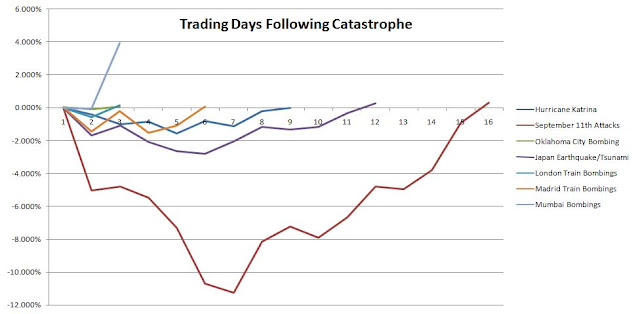It is in moments of great tragedy that America shows its unity and resiliency. In these very same moments, at least in the short-term, the stock market is far less resilient. At 2:50 pm EST on Monday (approximate time of the explosion), the S&P 500 was trading at 1,567. Over the next hour, it dropped 0.8% to close at 1,552.
Could this be the event that puts an end to the recent strong stock market?
Not likely.
Historically, these shocking events have had little long-term effect. We believe the Boston Marathon attacks will prove to be no different. The chart below shows the stock markets’ reaction to seven of the most significant natural disasters and terrorist acts of the past 20 years:

The chart shows the number of trading days it took the S&P 500 to close at a price higher than the day of the incident (or day previous if the event occurred on weekend or during closed markets). As you can see, the most significant event was the terrorists’ attacks on September 11th. In seven trading days, the market plummeted 11%. In the 10 trading days following that low, the market recovered above where it opened on September 11th. While each of these seven cataclysmic events created anxiety and uncertainty for long periods after they occurred, they had virtually no long-term effect on the stock market.
The events on April 15th were a reminder that evil still resides in some dark souls, but the markets will continue to be driven in the future as they have been in the past - by corporate earnings and dividend growth.
If anything, these terrorist attacks and the mixed economic data over the past few weeks will keep the Fed’s stimulative monetary policy continuing even longer. That’s bad news for a bond market already starving for yield. A 5-year U.S. Treasury bond is yielding 0.70%, 10-year bonds are yielding 1.7%, and the 30-year yield is currently 2.8%. In all cases, inflation would wipe out any real return from these “riskless” investments. This is also the case with many other types of bond alternatives.
Regardless of what horrible things are going on in the world, the question still facing every investor is this: If you run from stocks, where do you go for income - or even for the potential of a reasonable rate of return?
We have been saying for years that from an investment perspective, there is no place to hide. Yet, there are a number of good places to ride out the storms we are traversing. High quality, dividend-paying stocks are our number one choice. These kinds of stocks have successfully weathered every storm - both natural and man-made - that the world has thrown at them for over a hundred years and produced rates of return over double that of Treasury bonds.
